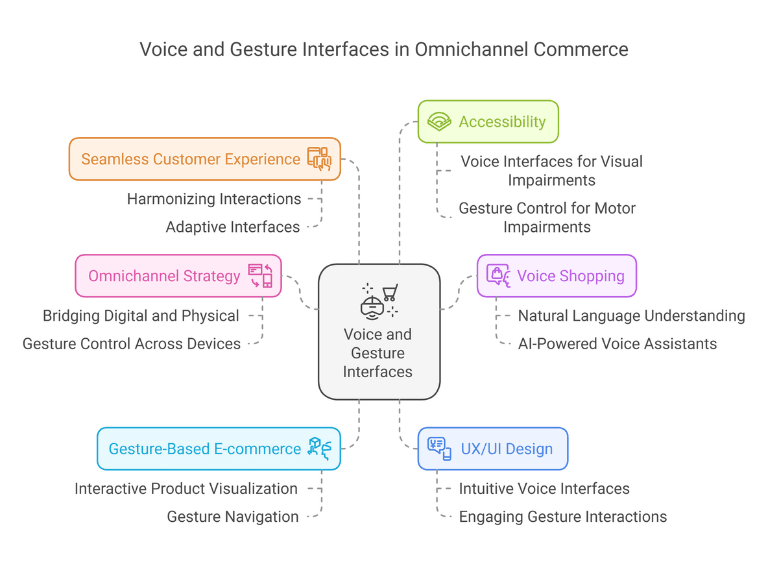Seamless Shopping in 2025: Voice and Gesture Interfaces Driving Omnichannel Commerce
Iliya Timohin
2025-01-27
The retail landscape is undergoing a rapid transformation, and by 2025, voice and gesture interfaces will be pivotal in shaping the online shopping experience. This article explores how these technologies are converging to create seamless and intuitive omnichannel shopping experiences.

1. Omnichannel Strategy 2025: Integrating Voice and Gesture for a Unified Customer Journey
An effective omnichannel strategy hinges on providing a consistent and integrated experience across all customer touchpoints. Voice and gesture interfaces offer powerful tools to achieve this.
Bridging the Digital and Physical with Voice-Activated In-Store Experiences
Voice commands are revolutionizing in-store interactions. Customers can use voice assistants on their smartphones or dedicated in-store devices to quickly access product information, navigate store layouts, and receive personalized offers based on their past purchases or browsing history. This enhances the customer experience by providing instant access to information and personalized assistance, reducing the need to search for staff. For example, a shopper could ask, "Where can I find organic coffee?" and receive precise directions to the relevant aisle. This integration of voice search in physical retail, as highlighted by the National Retail Federation (NRF), helps bridge the gap between digital and physical shopping.
Gesture Control for Seamless Transitions Across Devices
Consistent gesture controls across devices (smartphones, tablets, smart TVs, and in-store kiosks) are crucial for a unified customer journey. Imagine a shopper browsing products on their smartphone using swipe gestures. Upon arriving home, they can seamlessly continue browsing on their smart TV using similar gestures, creating a continuous and intuitive experience. Such a cross-platform experience, as described by the Interaction Design Foundation, strengthens connections between different touchpoints, allowing customers to interact with brands across various screens without encountering radically different interfaces.
Personalization Through Voice and Gesture Data for Enhanced Omnichannel Engagement
Data gathered from voice queries and gesture interactions provides valuable insights into customer preferences and behaviors. Analyzing this data enables businesses to create highly personalized offers, targeted marketing campaigns, and relevant product recommendations. For instance, if a customer frequently uses gestures to zoom in on specific product details, the system can infer their interest in those features and highlight similar products. This data-driven personalization approach, as explained by the Harvard Business Review, improves omnichannel interaction by providing customers with relevant and timely information at every stage of their journey.
2. Voice Shopping 2025: Transforming Search and Purchase with Conversational AI
Conversational AI is transforming how customers search for and purchase products online.
Natural Language Understanding for More Accurate and Relevant Voice Search
Natural Language Understanding (NLU), a subset of Natural Language Processing (NLP), is essential for interpreting complex voice queries, understanding synonyms, and discerning user intent. This allows voice search to move beyond simple keyword matching and provide more accurate and contextually relevant results. For example, a user might say, "Find me a comfortable pair of running shoes for trail running," and the system should be able to understand the specific requirements (comfortable, running shoes, trail running) and provide relevant options. This process utilizes advanced NLP techniques discussed in the Google AI Blog.
AI-Powered Voice Assistants for Personalized Shopping Experiences
Voice assistants are becoming increasingly sophisticated, offering personalized product recommendations, proactive suggestions, and seamless price comparisons. They can guide users through the entire purchase process, from product discovery to checkout. Imagine a user asking their voice assistant, "What are some good deals on laptops right now?" The assistant could then provide a curated list of laptops based on the user's past browsing history, budget, and desired features. This personalized approach to voice shopping enhances customer convenience and satisfaction.
Voice Payments and Secure Authentication for Frictionless Transactions
Voice payments, coupled with biometric authentication (voice recognition, fingerprint scanning), offer a frictionless and secure checkout experience. Customers can quickly and easily authorize transactions using simple voice commands, eliminating the need for manual input of credit card details. This enhances the overall shopping experience by reducing friction at the crucial point of purchase. The security of these transactions is extremely important and complies with standards described by EMVCo.
3. Gesture-Based E-commerce: Enhancing Product Discovery and Interaction in 2025
Gesture interfaces provide a more interactive and engaging way for customers to interact with products online.
Interactive Product Visualization with Gesture Control
Gesture control allows customers to interact with 3D product models in a more natural and intuitive way. They can use gestures to rotate models, zoom in on details, and view products from different angles. This provides a more immersive and informative experience compared to static images, allowing customers to better evaluate products before making a purchase. Technologies such as glTF ensure efficient transmission and rendering of 3D models on the internet, enhancing this interactive interaction.
Gesture Navigation for Intuitive Browsing and Filtering
Intuitive gesture-based navigation can streamline the browsing and filtering process in e-commerce applications. Simple gestures like swiping can be used to navigate between product pages, categories, and filters, making the shopping experience more seamless and efficient, especially on mobile devices. This contributes to a more intuitive and user-friendly experience, similar to the principles discussed in the W3C Pointer Events specification.
Gesture Recognition for Personalized Recommendations and Product Suggestions
By analyzing user gestures, e-commerce platforms can gain insights into customer preferences and provide highly personalized recommendations. For example, if a user consistently uses gestures to zoom in on fabric textures, the system can infer their interest in material quality and suggest products with similar materials. This personalized approach increases customer engagement and satisfaction.
4. UX/UI for Voice and Gesture Commerce: Design Best Practices for 2025
Designing effective voice and gesture interfaces requires careful consideration of UX/UI principles.
Designing Intuitive Voice Interfaces for E-commerce
Designing effective voice interfaces involves focusing on natural language understanding, providing clear and concise feedback, and ensuring a smooth conversational flow. The interface should be able to handle various types of queries, including complex requests, synonyms, and follow-up questions.
Creating Engaging Gesture Interactions for Online Shopping
Designing engaging gesture interactions involves choosing intuitive gestures that are easy to learn and use. Providing clear visual feedback is crucial to confirm user actions and prevent errors. Ergonomic considerations are also important to ensure that gestures are comfortable and do not cause fatigue.
Combining Voice and Gesture for a Seamless Multimodal Experience
Combining voice and gesture input creates a richer and more versatile user experience. This multimodal approach allows users to interact with the system in the way that is most convenient for them in a given context. For example, a user might use voice search to find a product and then use gestures to interact with a 3D model of that product. More information about using AI to improve UX research and prototyping, including data analysis and personalization techniques applied to voice and gesture interfaces, can be found in our article: Leveraging AI for UX Research and Prototyping.
5. Seamless Customer Experience: Combining Voice, Gesture, and Traditional Interfaces in 2025
The future of e-commerce lies in the seamless integration of voice, gesture, and traditional interfaces.
Harmonizing Voice, Gesture, and Touch Interactions for a Unified Brand Experience
Maintaining brand consistency across all interaction modalities (voice, gesture, touch) is crucial for creating a unified and recognizable brand experience. This includes using consistent language, visual design, and interaction patterns across all channels. For instance, if a user uses a specific voice command to add an item to their cart on a website, a similar voice command should work in the mobile app. Similarly, if a specific gesture is used to zoom in on a product image on a tablet, the same gesture should ideally work on a touchscreen kiosk in a physical store. This consistent experience strengthens brand recognition and reduces user confusion.
Adaptive Interfaces: Catering to Individual User Preferences and Context
Adaptive interfaces that dynamically adjust to individual user preferences and context are essential for providing a truly personalized experience. The system should be able to learn from user behavior and adapt its interface accordingly. For example, if a user consistently uses voice commands for searching but prefers touch interactions for browsing product details, the system should prioritize those interaction modalities accordingly. This personalized adaptation makes the shopping experience more efficient and enjoyable.
Optimizing the Customer Journey Across All Touchpoints with Multimodal Interactions
Multimodal interfaces can optimize the customer journey at every touchpoint, from initial product discovery to post-purchase support. By offering a variety of interaction modalities, businesses can cater to diverse user needs and preferences, leading to a more satisfying and efficient shopping experience. Imagine a user starting their shopping journey by asking a voice assistant for product recommendations, then using gestures to explore 3D models of those products on a tablet, and finally completing the purchase using touch on their smartphone. This seamless transition between modalities creates a truly omnichannel experience.
6. Accessibility in E-commerce 2025: Empowering All Users with Voice and Gesture Control
Voice and gesture interfaces have the potential to significantly improve accessibility in e-commerce.
Designing Voice Interfaces for Users with Visual Impairments
Voice interfaces offer a powerful way for users with visual impairments to access and interact with e-commerce websites. By using voice commands, they can navigate websites, search for products, and complete purchases without relying on visual cues. Adhering to web accessibility guidelines like WCAG (Web Content Accessibility Guidelines) is crucial for creating accessible voice interfaces. This includes providing clear audio cues, descriptive voice feedback, and ensuring that all interactive elements can be accessed through voice commands.
Implementing Gesture Control for Users with Motor Impairments
Gesture interfaces can also improve accessibility for users with motor impairments. By providing simple and intuitive gestures, they can control websites and interact with products without requiring fine motor skills or precise movements. This is particularly beneficial for individuals with conditions like arthritis, tremors, or limited hand mobility. For example, instead of requiring a precise click on a small button, a user could perform a simple swipe or tap on a larger area of the screen. Careful consideration should be given to the types of gestures used, ensuring they are easily performed and require minimal effort. Research from organizations like the Trace Research & Development Center provides valuable insights into designing accessible interfaces for users with motor impairments.
Ensuring Inclusive Design for Multimodal E-commerce Experiences
Designing inclusive multimodal experiences means considering the needs of a diverse user base, including those with visual, auditory, cognitive, and motor impairments. This requires providing multiple interaction modalities (voice, gesture, touch) and ensuring that each modality is accessible and usable for everyone. For example, providing both voice commands and gesture controls allows users to choose the interaction method that best suits their abilities and preferences. Following inclusive design principles, such as those outlined by Microsoft Inclusive Design, ensures that e-commerce platforms are accessible and usable by everyone, regardless of their abilities.

Final Thoughts
Voice and gesture interfaces are poised to revolutionize the e-commerce landscape by creating more immersive, personalized, and accessible shopping experiences. By 2025, these technologies will be integral to omnichannel strategies, enabling businesses to connect with customers across multiple touchpoints in a seamless and intuitive way.
Embracing voice and gesture commerce is not just a trend; it's a strategic imperative for businesses seeking to enhance customer engagement, drive sales growth, and remain competitive in the evolving digital marketplace. By focusing on user-centered design, accessibility, and the seamless integration of these technologies with existing platforms, businesses can unlock the full potential of voice and gesture commerce and create truly transformative shopping experiences.
